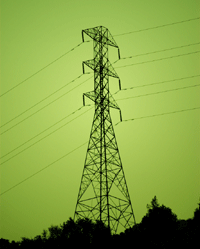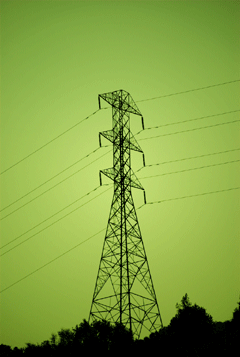Greening the Grid
Air Date: Week of February 27, 2009

(Photo: Stephen Migol)
The U.S. has some of the world's greatest potential for power from the wind and sun. But getting that clean electricity to where it's needed means many miles of new electric transmission and building new power lines is a costly and often controversial job. Living on Earth's Jeff Young reports on a new high-power effort to green the grid.
Transcript
GELLERMAN: It’s Living on Earth, I’m Bruce Gellerman.
[SOUND FROM CONGRESS “MADAME SPEAKER, THE PRESIDENT OF THE UNITED STATES” APPLAUSE.]
GELLERMAN: It wasn’t officially a State of the Union address. But President Barack
Obama’s first speech to Congress had all the trappings and high expectations of one as he laid out his plan to jumpstart the stalled economy.
OBAMA: It begins with energy.
GELLERMAN: Energy is so important to President Obama’s plans for the future of the nation he put it at the very top of his speech. And he challenged lawmakers to top their agenda with limits on the green house gases from burning fossil fuels.
OBAMA: So I ask this Congress to send me legislation that places a market-based cap on carbon pollution and drives the production of more renewable energy in America. [Applause] That’s what we need. [Applause.]
GELLERMAN: Selling credits for carbon emissions would be a new source of revenue for the federal government, raising as much as 300 billion dollars a year. Money that would be used for tax cuts and re-tooling the energy economy including thousands of miles of new high-tension power lines. But Living on Earth’s Jeff Young says there are some high hurdles to building a greener grid.
YOUNG: Senate majority leader Harry Reid, the Democrat from Nevada, drew a high-power crowd to his clean energy summit at Washington’s gleaming Newseum Building.
President Bill Clinton took the seat next to Reid and House Speaker Nancy
Pelosi settled in nearby. Legendary oilman turned wind power advocate T. Boone Pickens found himself sandwiched between two Nobel laureates—Al Gore and new energy secretary Steven Chu.
PICKENS: I hope there is a camera here and has me between the two Nobel leaders. It would be very exciting if my mother was still alive to see that. [Laughter]
YOUNG: Moderator Tim Wirth, former Colorado senator, hopes the assembled star power will put the spotlight on an otherwise low wattage issue: the nation’s electric grid.
WIRTH: As I would call it one of the most anesthetizing issues there is. If you ask a constituency what do they think about the grid they go blank right away and move on to the next question.
YOUNG: The two dozen panelists piled on the reasons people concerned about climate and energy should be thinking about the grid. In short, it’s the missing link in the path to a clean energy future. Some called for an electron superhighway, much the same way we once built an interstate highway system. Massachusetts democratic representative Ed Markey likened it to early efforts to electrify the country.
MARKEY: Back in the 1930s, urban America decided they were going to fund construction of electric lines to bring it out to rural America. Now we have to decide how to get it in from the prairies into the cities.
YOUNG: It will not be easy or cheap. The recently passed economic stimulus bill includes 11 billion dollars in support for grid improvements and expansion. That figure’s dwarfed by cost estimates for new lines that would link the Great Plains to cities in the Midwest and Northeast.
But money might not be the biggest obstacle. New transmission lines run into a briar patch of siting and permitting problems. High voltage lines can cut through scenery and carve up sensitive habitat. Landowners fear lost property value, and local governments fear getting saddled with costs for projects that don’t benefit them. Former New York Republican Governor George Pataki offered the panel a reality check.

(Photo: Stephen Migol)
PATAKI: Tell someone you’re going to run wires through their community that come from one state and run through to another state? You don’t have to take a poll. No one is gonna be for it! What is missing is the ability of those who desire to build this transmission system to actually get approval and the permit to do it. It takes years, it takes hundreds of millions of dollars, and at best the outcome is uncertain.
YOUNG: Even when the purported goal is to carry clean energy, power lines can still end up generating controversy. Case in point: a line called Sunrise Powerlink. It’s supposed to link San Diego to new solar generation planned in the desert to the east. A natural way to win support from eco-conscious Californians, right? Wrong.
ZICHELLA: It’s a poster child for how to do a transmission line wrong.
YOUNG: That’s Sierra Club’s Carl Zichella. He says the 150-mile line would threaten desert habitat with few assurances that it would really carry solar power. A natural gas facility lies nearby to the south. The Sunrise project got preliminary approval from the state but now faces legal challenges from environmental groups.
Zichella’s been fighting that and other power line proposals for years. But he recently joined a coalition of renewable energy advocates and businesses who want to find a way they can support new power lines.
ZICHELLA: For folks that have been advocating for renewable energy for years as a solution to the climate crisis you can’t love renewable energy if you don’t like transmission. And we’re gonna have to learn to like transmission. And the only way we’ll learn to like it is by putting it in the right places.
YOUNG: Zichella says those who want new lines have to learn from past mistakes. They should include more people in the planning process and guarantee those new lines will really carry clean energy.
John Podesta says the key to resolving these issues is to start thinking big. Podesta’s a power player in Washington these days. He led then President-elect Obama’s transition team. And Podesta’s think tank, the Center for American Progress, helped Senator Reid organize the energy summit.
PODESTA: What’s happened is people understand energy is a national problem that needs a national solution. And I think that what is gonna be essential is that state sensibilities are taken into account. But it has to feed into a national system. If we had had the same attitude in 1950s about every road needs to be only thought about by local communities we’d have never built the interstate highway system.
YOUNG: Podesta calls the current patchwork of state regulations “byzantine, balkanized and broken.”
But state officials are leery of a federal approach that would put them on the sidelines. Fred Butler directs the National Association of Regulated Utility Commissioners. The commissioners oppose more federal control. But Butler can also read the writing on the political wall and says his group is reconsidering.
BUTLER: We kind of see this movement gaining some momentum and we want to be at the table to discuss it. So if our position is no, no, no, a thousand times no, then we kind of feel that we might not be part of the discussion.
YOUNG: One thing is sure: All these tough questions about how to best plan, permit and pay for clean energy transmission will no longer be in the political shadows. They’ll be front and center as congress considers a bill by Senator Reid that would give the federal government a greater role.
REID: You should be aware that what we’re talking about doing is making it possible for this energy that we’re creating all over the United States to take it where it’s needed. But we’re going to move beyond – and that’s part of the conversation today – one state being able to hold up forever something that needs to be done for the rest of the country.
YOUNG: And as for concerns from state officials, well, Reid, a former boxer, made it clear he’s ready to flex some muscle.
REID: Whatever we pass at the federal level trumps all that. Okay?
YOUNG: Reid’s proposal is winning early support from clean energy advocates, who call it a nice balance of state and local input and federal authority to get projects done. But it could still be a tough sell on Capitol Hill where lawmakers want to make sure their voters back home still have some power over power line decisions.
For Living on Earth, I’m Jeff Young in Washington.
Links
Living on Earth wants to hear from you!
Living on Earth
62 Calef Highway, Suite 212
Lee, NH 03861
Telephone: 617-287-4121
E-mail: comments@loe.org
Newsletter [Click here]
Donate to Living on Earth!
Living on Earth is an independent media program and relies entirely on contributions from listeners and institutions supporting public service. Please donate now to preserve an independent environmental voice.
NewsletterLiving on Earth offers a weekly delivery of the show's rundown to your mailbox. Sign up for our newsletter today!
 Sailors For The Sea: Be the change you want to sea.
Sailors For The Sea: Be the change you want to sea.
 The Grantham Foundation for the Protection of the Environment: Committed to protecting and improving the health of the global environment.
The Grantham Foundation for the Protection of the Environment: Committed to protecting and improving the health of the global environment.
 Contribute to Living on Earth and receive, as our gift to you, an archival print of one of Mark Seth Lender's extraordinary wildlife photographs. Follow the link to see Mark's current collection of photographs.
Contribute to Living on Earth and receive, as our gift to you, an archival print of one of Mark Seth Lender's extraordinary wildlife photographs. Follow the link to see Mark's current collection of photographs.
 Buy a signed copy of Mark Seth Lender's book Smeagull the Seagull & support Living on Earth
Buy a signed copy of Mark Seth Lender's book Smeagull the Seagull & support Living on Earth

